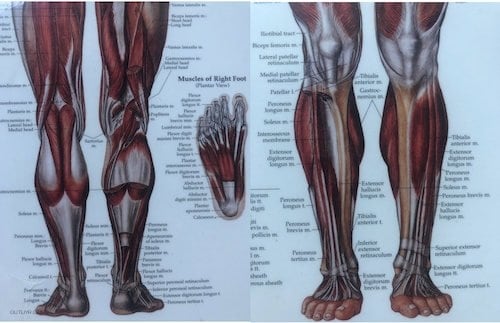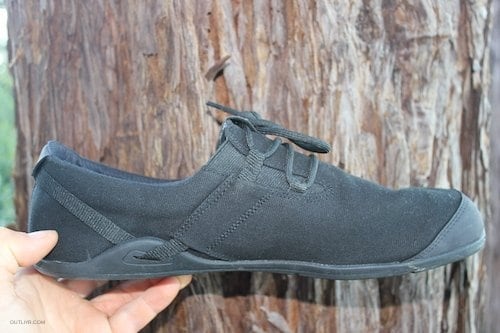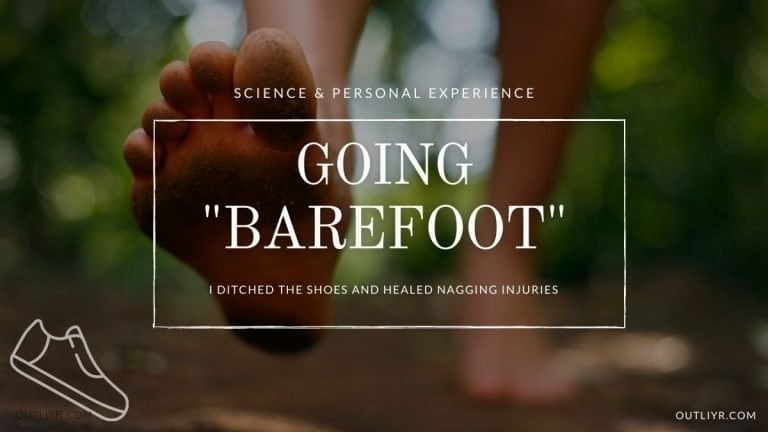An athlete’s career can evaporate in the blink of an eye.
Whether you’re a weekend warrior or hard-charging competitor, every injury can derail months (or years) of blood, sweat, and tears.
I suffered an ankle injury (video at bottom of post) early into a championship rugby match. I made the naive mistake of limping my way through the final 70 minutes. Even weeks and months later, daily rehab didn’t heal my ankle.
I looked into my options, other rehab exercises, and alternative healing modalities. One day I stumbled upon what sounded like a ridiculous idea.
Wear no shoes at all. Go barefoot.
Not exactly feasible, but a new suggestion. I found online forums, videos, articles, and some research on the ancestral idea. The more I researched, the more comfortable I felt with this radical change.
I decided to look for the most “barefoot” shoes I could find.
These are not toe shoes. Shoes should look good, feel comfortable, and importantly not impede my performance.
“Most running shoes today are designed and constructed in such a manner as to make correct technique impossible (and therefore cause chronic injuries to the people who wear them).”
Gordon Pirie
This post will explore the scientific benefits of wearing barefoot and minimalist shoes. Build strength, improve your conditioning, reduce injury risk, and improve posture simply by changing your shoes.
There’s a dark side to the latest stylish and ultra-cushioned footwear. At the end I’ll reveal my favorite barefoot shoe brand.
What Are Minimalist and Barefoot Shoes?
Barefoot shoes have a lot in common with your traditional shoe. They come in all forms from sandals to formal. So what makes them different?
Minimalist and barefoot shoes both feel close to actually being barefoot. Both types of shoes share similar characteristics:
- An extremely thin layer of sole between your foot and the ground
- Very lightweight and flexible
- “Zero drop” meaning that your heel is not elevated
Yes, calling a shoe “barefoot” is in itself an oxymoron. So what’s the difference?
- Minimalist shoes resemble traditional shoes and are perfect for beginners.
- Barefoot shoes are more extreme with even thinner soles, lighter, and as close as you can get to being barefoot while still covering your feet.
You Should Consider Going Minimalist
Living barefoot passes the ancestral sniff test. Humans walked, jogged, and ran barefoot or in minimal shoes up until recent times. Until my injury, I didn’t think much about my feet, ankles, or walking.
My shoe choice came down to color, style, and brand.

The more I thought about it, the more I realized the mistake of ignoring the feet and surrounding musculature. The tissues used to move (your kinetic chain), start at the feet and go all the way up to the head. A weak link early in the chain causes problems the rest of the way up. Get it wrong and you’ll perform suboptimally. Or set yourself up for issue later.
Most of us get it wrong, including professional runners.
I’m not a fan of frequent, intense, long running sessions. I wrote about the rarely-discussed reasons running is bad for you.
Consequences of improper running technique include additional strain on the feet, ankles, knees, back, and hips. You become a ticking injury time bomb. Unsurprisingly, more than half of the running population gets injured every year.
Going barefoot improves your movement efficiency, strengthens your natural stabilizers, and keeps you active.
Barefoot Shoe Benefit #1: You Will Move Better
For something we do effortlessly, movement takes great coordination. Large groups of muscles fire together at precise timings as they go through varying angles and planes. The slightest tweak to that delicate system negatively impacts everything.
Movement starts with the feet and ankles. Get an angle wrong here and you misalign everything above.
I never loved geometry, but I learned the importance of angles early on in my sports career.
Muscles generate more power in specific angles. Tiny 170-pound wide receivers strategically use this knowledge to move giant 250-pound linebackers. The closer we get to barefoot running, the more optimal and powerful the angle we use to strike the ground.
For the athletes, optimize your angles to generate more force and power!
These angles carry all the way up the body. Hip and torso mobility greatly improves. Over time your limited range of motion expands, enabling you to do more with increasing effectiveness.
Barefoot Shoe Benefit #2: Use or Lose Your Stabilizers

A common biological adage holds true with your foot and ankle muscles: use it or lose it. You have over 100 muscles in your feet and ankles alone.
Modern shoe technology promises to stabilize your feet, ankles, and protect against injury. They do a great job. So great that those muscles get to shut down. Those 100 shutdown muscles atrophy and shrink. Then when you need them for support, they fail.
How does this compare to going barefoot?
The admittedly sparse research indicates that it significantly changes gait for the better. Another study found improved stability and physical function in middle-aged adults.
Muscles of the foot and ankle engage to support movement. Constant engagement strengthens them, leading to greater balance without a dedicated training program. It may not seem like a big deal, but strong stabilizer muscles prevent injury.
Barefoot Shoe Benefit #3: Alleviates Pain and Reduces Injury Risk
Back to traditional footwear.
The more you rely on footwear to absorb impact, the less your body needs to handle. Your body does the logical thing and focuses on sending nerve signals to areas of the body where they matter more. You become less sensitive to subtle feedback cues.
Dr Joel Seedman points out that seemingly disconnected problems throughout the body can stem from faulty footwear:
- Poor spinal alignment
- Low back pain
- Neck impingement
- Shoulder injuries
- Inhibition/weakness of the upper extremities
A small tweak to your foot or ankle could fix a lifetime problem.
Best of all, you have nothing to lose from strengthening these muscles.
Why I Switched to Barefoot Shoes
How much activity can you do barefoot? My old answer was not much.
An injury spotlighted that in my years of “full-body” training I had neglected my feet, toes, and ankles.
I saw little downside in trying something new.
I began walking barefoot more. Sometimes (usually) I felt social pressure to wear shoes. I wasn’t exactly ready to show up at my office barefoot. I made a less drastic change. I retired my UltraBoosts and strapped on my first pair of minimal shoes. They felt like walking barefoot with the padding equivalent to a few sheets of paper under my feet. No real cushioning.
I already walked barefoot on occasion, so I knew what to expect, but I hadn’t ever experienced foot and ankle soreness like the first few days. They became my daily wear and I noticed new subtle sensations. A few weeks later I wore them on one of my occasional runs. I remember feeling looser than usual after that run.
Several months later I noticed my ankle pain had greatly subsided and I could go deeper into my squat than before.
Today I still wear normal shoes on occasion, but I prefer to go as minimalist as possible.
How to Get the Benefits of Barefoot and Minimalist Walking
I understand not wanting to make the jump to a whole new style of shoe. The transition took a week to feel normal, and it also meant a footwear overhaul.
If tossing your old shoes seems like too much change, you can strengthen the same muscle and proprioception mechanisms in other ways. Your feet, ankles, and toes deserve training like every other body part. You have several training options, and below I will cover why I prefer minimal shoes.
Incorporating Stability into Your Gym Routine

Gyms have all kinds of gear that I don’t know the function of. For years I thought that Bosu Balls, the strange half ball pictured above, wasted time, effort, and money.
Science becoming a Chek Integrated Movement Scientist, I’ve reconsidered. Performing compound movements on unstable surfaces causes a greater hormonal response and thus greater fitness gains. In addition, it strengthens often neglected deep muscles of the core like the TRA. Finally, unstable training builds functional strength.
Go Barefoot When Possible
I recently heard a quote that you shouldn’t skimp when it comes to your bed and shoes since you’ll be in one of the two 24 hours daily.
That’s true for most of us, most of the time.
Right now I am working from home and don’t need my shoes.
Keeping the shoes off whenever possible gives your stabilizers a little attention. It’s also a great way to gradually transition from normal to barefoot shoes.
Choose the Sensible Shoes
On the opposite end of barefoot shoes, you have high heels and platforms.
I have no qualms with their occasional use. They look great, and compliment a nice outfit for special occasions.
Thick, padded sneakers and platforms worn on a daily basis? More of an issue.
Over time your footwear can change your postural alignment. A mere one-degree thoracic or lumbar angle change can disrupt digestion, cause pain, and other symptoms. Wear them often, and your body will adjust your baseline posture accordingly. Leading to common issues like kyphosis, lordosis, and forward head posture.
The higher and less natural the foot position, the more likely you’ll eventually have problems.
Minimal and Barefoot Shoes I Like
I wear barefoot shoes daily and have done so for years. From my extensive testing…
I’ve come to the conclusion that for most people, minimal shoes are ideal for everyday use, while barefoot shoes are best for running.
I’ve used and heard great things about two brands in particular.
I personally have the Xero Hana’s and have loved them so far.
They’re made of canvas that’s casual enough to wear out, fancy enough for a casual startup work environment. The Hana is comfortable and backed by a 5,000-mile sole warranty (which I can confirm that they honor). Their shoes come in multiple colorways.

Check them out.
Barefoot Shoes to Strengthen Stabilizers, Build Fitness, & Prevent Injury
Our stabilization muscles need extra attention. Strong stabilizers improve your movement efficiency, generate more power, reduce the risk of injury, and can alleviate pain all throughout the body.
I tried many different approaches before I found barefoot shoes. I didn’t see immediate results, but over time I’ve noticed significant recovery in my ankle and feet. I move better, squat deeper, and my shin splints have disappeared.
You don’t need to buy new shoes. Instead, you can add stability work into your fitness routine, spend more time truly barefoot, or opt for your thinner-soled shoes.
No matter what method you choose, start slow. The last thing you want is to cause pain or injury from transitioning too fast.
Cheers to your stronger, more capable body.
Oh, and by the way, here’s that video I mentioned. You might have to watch a few times to see the ankle:



